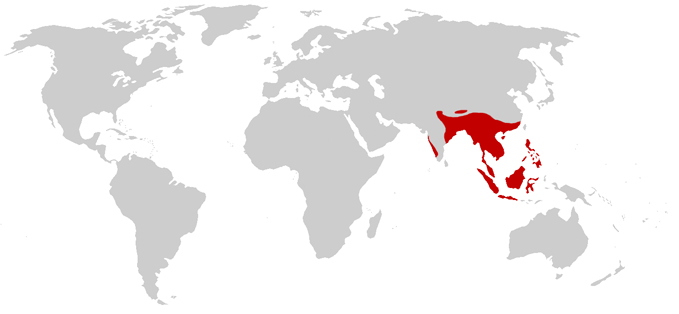Facts
Type : Reptile
Diet : Carnivore
Average life span in the wild: 20 years
Size : 13 ft (4 m)
Weight : Up to 20 lbs (9 kg)
Group name : Quiver
Did you know?
Synthetic cobra venom is used in pain relievers and arthritis medication.
Size relative to a 6-ft (2-m) man:
Regional Distribution

Scientific classification
Kingdom: Animalia
Phylum: Chordata
Class: Reptilia
Order: Squamata
Suborder: Serpentes
Family: Elapidae
Genus: Ophiophagus
Species: O. hannah
It seems unfairly menacing that a snake that can literally "stand up" and look a full-grown person in the eye would also be among the most venomous on the planet, but that describes the famous king cobra.
King cobras can reach 18 feet (5.5 meters) in length, making them the longest of all venomous snakes. When confronted, they can raise up to one-third of their bodies straight off the ground and still move forward to attack. They will also flare out their iconic hoods and emit a bone-chilling hiss that sounds almost like a growling dog.
Their venom is not the most potent among venomous snakes, but the amount of neurotoxin they can deliver in a single bite—up to two-tenths of a fluid ounce (seven milliliters)—is enough to kill 20 people, or even an elephant. Fortunately, king cobras are shy and will avoid humans whenever possible, but they are fiercely aggressive when cornered.
King cobras live mainly in the rain forests and plains of India, southern China, and Southeast Asia, and their coloring can vary greatly from region to region. They are comfortable in the trees, on land, and in water.
King cobra's genus name, Ophiophagus, literally means "snake-eater", and its diet consists primarily of other snakes, including rat snakes, sizeable pythons and even other venomous snakes (including kraits, cobras and smaller members of its own species). When food is scarce, they may also feed on other small vertebrates, such as lizards, birds, and rodents. In some cases, the cobra may “constrict” its prey, such as birds and larger rodents, using its muscular body, though this is uncommon. After a large meal, the snake may live for many months without another one because of its slow metabolic rate. The king cobra's most common meal is the ratsnake; this leads them near human settlements.
They are the only snakes in the world that build nests for their eggs, which they guard ferociously until the hatchlings emerge.
King cobras may be best known as the species of choice for the snake charmers of South Asia. Although cobras can hear, they are actually deaf to ambient noises, sensing ground vibrations instead. The charmer's flute entices the cobra by its shape and movement, not by the music it emits.


 09.16
09.16
 fahmi adhoc
fahmi adhoc




0 comments:
Posting Komentar